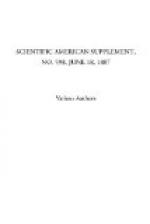During the recent mining, the largest fine crystal of lithia emerald ever found was also brought to light. It measures 23/4 inches by 3/5 of an inch by 1/3 of an inch. One end is of a very fine color, and would afford the largest gem of this mineral yet found, and one which would probably weigh 51/2 carats. With this there was a number of superior crystals and some ounces of common pieces of the same mineral. The company estimates the value of this entire yield of hiddenite at about $2,500.
There was also found a quantity of quartz filled with white byssolite, forming very attractive specimens and valued at $250.
A number of beryls of a fine blue color, resembling the Mourne Mountain specimens, were found near Mount Antero, Chaffee County, Col. One of these was 4 inches long and 3/8 of an inch across, with cutting material in it. The other crystals measured from 1 to 11/4 inch in length, and from 1/5 to 1/3 inch in width.
The large beryl mentioned by Mr. Kunz in the Mineral Resources for 1883 and 1884 has afforded the finest aquamarine of American origin known. It is brilliant as a cut gem, and, with the exception of a few internal hair-like striae, is absolutely perfect. It weighs 1333/4 carats, measures 1-2/5 x 1-2/5 x 4/5 inch, and is of a deep bluish green, equal to that of gems from any known locality.
Mr. G.F. Breed, manager of the Valencia Mica Company, has cut nearly one hundred aquamarines, ranging from 1/2 carat to 4 carats in weight, and of a light blue color, from white beryls found in the company’s mica mine at North Grafton, N.H.
A number of fine, deep golden-yellow, blue, and green beryls, equaling any ever found, have been taken by Mr. M.W. Barse from his mica mine between New Milford and Litchfield, Conn. Some fine blood-red garnets from this same locality have been cut into gems.
The largest phenacite crystal ever found is owned by Mr. Whitman Cross. It was discovered at Crystal Park, Col., weighs 59 pennyweights 6 grains, and measures 1-4/5 inch in length and 1-1/5 inch in thickness.
Thousands of garnet crystals, found at Ruby Mountain, near Salides, Col., have been made into paperweights and sold to tourists. Those that weigh a few ounces sell for about ten cents each. One was sold that weighed 14 pounds. Apropos of garnets, the discovery, in the heart of New York city, of as fine a crystal as was ever found on this continent, and weighing 9 pounds 10 ounces, may be mentioned as a matter of peculiar interest.
Several thousand dollars’ worth of the wood jasper of Arizona has been cut into paper weights, charms, and other objects, or polished on one side for cabinet specimens. Numbers of these articles are now being cut and sold to tourists along the line of the Atchison, Topeka, and Santa Fe Railroad.
The compact quartzite of Sioux Falls, Dakota, is being quarried and polished for ornamental purposes. It is known and sold as “Sioux Falls jasper,” and is really the stone referred to by Longfellow in his Hiawatha as being used for arrow heads. This stone takes a very high polish, and is found in a variety of pleasing tints, such as chocolate, brownish-red, brick-red, and yellowish. For the two years previous to 1885, $15,000 worth of it was sold.




